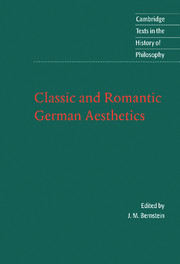Book contents
- Frontmatter
- Contents
- Introduction
- Chronology
- Further reading
- Note on the texts
- Aesthetica in nuce: A Rhapsody in Cabbalistic Prose (1762)
- Laocoön: An Essay on the Limits of Painting and Poetry (1766)
- From ‘On the Artistic Imitation of the Beautiful’ (1788)
- ‘Kallias or Concerning Beauty : Letters to Gottfried Körner’ (1793)
- ‘Oldest Programme for a System of German Idealism’ (1796)
- ‘Letter to Hegel, 26 January 1795’
- ‘Being Judgement Possibility’ (1795)
- ‘The Significance of Tragedy’ (1802)
- ‘Remarks on Oedipus’ (1803)
- From Miscellaneous Remarks (1797)
- ‘Monologue’
- ‘Dialogues’ (1798)
- ‘On Goethe’ (1798)
- ‘Studies in the Visual Arts’ (1799)
- From ‘Critical Fragments’ (1797)
- From ‘Athenaeum Fragments’ (1798)
- From ‘Ideas’ (1800)
- ‘On Goethe's Meister’ (1798)
- ‘Letter About the Novel’ (1799)
- ‘On Incomprehensibility’ (1800)
- Index
- Cambridge texts in the history of philosophy
Introduction
Published online by Cambridge University Press: 05 June 2012
- Frontmatter
- Contents
- Introduction
- Chronology
- Further reading
- Note on the texts
- Aesthetica in nuce: A Rhapsody in Cabbalistic Prose (1762)
- Laocoön: An Essay on the Limits of Painting and Poetry (1766)
- From ‘On the Artistic Imitation of the Beautiful’ (1788)
- ‘Kallias or Concerning Beauty : Letters to Gottfried Körner’ (1793)
- ‘Oldest Programme for a System of German Idealism’ (1796)
- ‘Letter to Hegel, 26 January 1795’
- ‘Being Judgement Possibility’ (1795)
- ‘The Significance of Tragedy’ (1802)
- ‘Remarks on Oedipus’ (1803)
- From Miscellaneous Remarks (1797)
- ‘Monologue’
- ‘Dialogues’ (1798)
- ‘On Goethe’ (1798)
- ‘Studies in the Visual Arts’ (1799)
- From ‘Critical Fragments’ (1797)
- From ‘Athenaeum Fragments’ (1798)
- From ‘Ideas’ (1800)
- ‘On Goethe's Meister’ (1798)
- ‘Letter About the Novel’ (1799)
- ‘On Incomprehensibility’ (1800)
- Index
- Cambridge texts in the history of philosophy
Summary
… words without spirit, method without inner illumination, figures of speech without feeling …
Moses MendelssohnAlmost from the moment that modern aesthetics took on a distinctive shape in the middle of the eighteenth century there arose claims that sought to privilege aesthetic reason or experience. In the writings collected in this volume we are offered the possibility of tracing the emergence and fate of this privilege. These writings are remarkably diverse in form, ranging from Lessing's subtle mixing of art theory with art criticism, Hamann's ‘rhapsody in cabbalistic prose’, the manifesto for a future aesthetic philosophy entitled ‘The Oldest Programme for a System of German Idealism’, through Schiller's letters to his friend, Körner, Hölderlin's to Hegel, and finally to the strange fragments, neither quite philosophy nor art, of Novalis and Friedrich Schlegel. This diversity in literary form has provided reason for philosophers to keep a cautious distance from these writings, comforting themselves with the more familiar articulations of aesthetic reason found in Kant's Critique of Judgement and Hegel's Aesthetics: Lectures on Fine Art, especially Hegel's long Introduction. While these works deserve the attention that has been paid to them, so too, I want to urge, do the writings collected herein. Their philosophical weightiness has been insufficiently appreciated. In a brief introduction, I thought the most helpful entrée into the world of these texts could be had through providing a theoretical framework that would characterize the main philosophical stakes running through them.
- Type
- Chapter
- Information
- Classic and Romantic German Aesthetics , pp. vii - xxxiiiPublisher: Cambridge University PressPrint publication year: 2002
- 3
- Cited by

